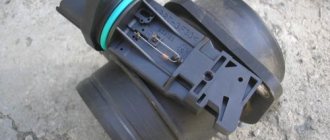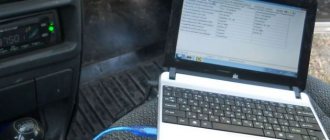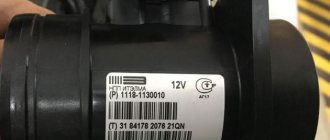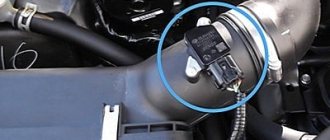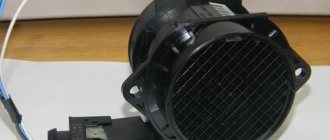The mass air flow sensor (MAF for short) shows how much air is filled in the cylinders when the engine is running. The mass air flow sensor is connected to the electrical harness of the 6-pin block and is located in the space between the air filter and the throttle valve. It is needed to measure the load on the engine and to ensure that fuel is supplied in the required quantity (to monitor this process, you just need to determine the mass of incoming air).
DMRV VAZ 2114
The MAF is of wire (thread) and film type; the fundamental difference is that for the wire type MAF the sensitive element will be a platinum wire, and for the film type there will be a film on which the measuring platinum resistor is attached. Regardless of the type, the mass air flow sensor tends to become dirty (platinum elements become covered with dust and do not work properly). Let's figure out how to clean the mass air flow sensor one by one.
The main reason for contamination of the air flow sensor is the condition of the air filter! If it is not good, then it begins to let in grains of dirt and dust with the air flow, which settle on the sensitive element of the sensor.
Cleaning the air flow sensor is required if:
- At idle the engine runs intermittently,
- The idle speed is unrealistically off the charts,
- When accelerating, it “stutters” (jerks or runs intermittently),
- Benz is consumed in large quantities,
- You basically can't start.
It also happens that the sensitive element itself is fine, but the connection between the sensor and the throttle module is malfunctioning (the connecting hose may crack). And this is a completely different story. Also, the controller may issue a check engine, which may indicate the same breakdown in the sensor connection circuit (or may indicate a completely different breakdown).
Every owner of a Russian car understands that, despite the obvious signs of a malfunction in a particular part of the car, these signs can relate to any other malfunction. Therefore, trust the signs, but check with specifics.
How to check for a faulty air flow sensor?
- Take a multimeter and set it to voltmeter mode;
- We set the measurement limit to 2 V;
- The sensor connector has a yellow wire (the signal is sent to the controller) and a green wire (the signal goes to ground);
- We measure the voltage between these wires: turn on the ignition, but do not start the engine!
- Let's see what the multimeter showed.
We met the limit from 0.99 to 0.02 - good, the sensor is in order; if the upper limit looms around 0.03 - the sensor is a bit old, it is necessary to urgently restore it to normal by cleaning. And if the arrow falls beyond the lower limit (0.95), or sharply exceeds the upper limit (0.05), there are 50/50 chances that flushing the mass flow sensor will help, and it will work like new, or go shopping for a new sensor.
By the way, there is another way to check the working condition of the mass air flow sensor at the fourteenth: disconnect the sensor and start the engine, floor to 2000 rpm, and get going. We drove around and realized that the car had “come to life” - the sensor should be cleaned.
Sensor diagnostics
There are several ways to test the performance of a flow meter; let’s consider the easiest and fastest one. To carry out diagnostics, you will need to disconnect the power connector from the mass air flow sensor, but the engine must be running. When the contact is disconnected, the control unit will begin to operate in emergency mode. Accordingly, as a result of this, the fuel dosage will be carried out according to the parameters that were received from the throttle.
It must be taken into account that in this case the speed of the power unit can increase sharply to 1500 per minute. However, this does not happen in all cars. With the flow meter turned off, you need to drive the car a little. If you notice that the performance of the power supply has improved, then most likely you need to change the mass air flow sensor (video author - Xie Dan).
Cleaning the air flow sensor of a VAZ 2114
Buying a new sensor (air meter) is not a cheap pleasure. Before you run to the nearest store, make sure that nothing can help your sensor.
And proper care can help him. Because incorrectly applied hands to this fragile element can completely destroy it. First, you need to understand how to clean the mass air flow sensor and what to use to clean it.
It was already said above that dirt collects on the sensitive element of the sensor: that is, on a platinum wire or platinum resistor (this is a system of very thin platinum fibers on a film type air meter). Sensitive elements are very delicate, do not try to clean them with the following products:
- Ester-containing liquids
- Ketone Liquids
- Liquids containing acetone
- Carburetor Cleaner
- Compressed air and matches with cotton wool!
For the sensor of any VAZ, including the fourteenth, there is a special liquid for flushing the mass air flow sensor - wd-40.
Cleaning DMRV VAZ 2114
Cleaning products
You can clean the regulator with different preparations and liquids:
- Liqui Moly. This is a company that produces cleaning products, oils and various types of liquids. According to the manufacturer, the products are of high quality, but cleaning the air flow sensor with its help will be expensive. The product is suitable for gasoline and diesel engines;
- Alcohol. An old but effective method of cleaning the mass air flow sensor. The chemical properties of alcohol allow it to combat contaminants on sensitive sensor components. The method works, but it is used less often than others;
- Liquid for carburetor engine. Effectively copes with any contamination;
- "Liquid Key" This cleaner cleans not only the mass air flow sensor, but also other transport components;
- WD-40. A universal product that cleans, removes rust, neutralizes squeaks, and so on.
In Moscow and other large cities, finding a suitable liquid is not difficult.
Step-by-step process
Purchase the required liquid, take a disposable syringe and a flat-head screwdriver. Even if you are a pro and know every crack of your car, still read the instructions again on how to clean the mass air flow sensor on a VAZ 2114. If you opened the hood of your fourteenth for the first time and you feel itchy, pray that everything goes smoothly, while reading the instructions at the same time.
- We opened the hood, found the sensor, removed it (loosen the fastening of the air filter hose with the sensor, unscrew the two nuts with a ten-socket wrench and voila, done);
- There is a part on the sensor that is screwed to its body with two bolts; it must be unscrewed;
- Inside, we spray the necessary liquid from a syringe onto the sensitive element (you can also rinse the contact system of the block);
- Let it dry.
All that remains is to put everything back in place and start the engine.
What is a mass air flow sensor, why is it important and how to diagnose its malfunction
Over the past three decades, engines with distributed and direct fuel injection have finally supplanted all other types of designs. It would seem that this is a considerable period of time, but engineers have not been able to overcome the “childhood diseases” of important electronic components, including the mass air flow sensor (MAF), which is responsible for the composition of the air-fuel mixture. Let's remember how the mass air flow sensor works, why it is so important and how to diagnose its malfunction.
What is DMRV
Modern engines use two types of power supply systems: with distributed injection, the nozzle supplies fuel to the intake pipe, with direct injection, it supplies fuel to the combustion chamber. For both systems, the correct operation of the mass air flow sensor, which was once mechanical (vane type), but is now devoid of moving mechanical parts and made hot-wire (from “anemo” - wind), is important.
Factory air flow sensor made in Germany for a VAZ engine
The mass air flow sensor can be installed not only on a gasoline engine, but also on a diesel engine, where the operation of the EGR valve (exhaust gas recirculation system) is “tied” to it.
As old-school drivers used to say, an internal combustion engine does not work in two cases: there is nothing to burn or there is nothing to set it on fire. The mass air flow sensor precisely informs the electronic control unit about the amount of incoming air, the oxygen of which becomes the “fuel” for the working mixture. Having received such a signal, the ECU can ensure the most complete combustion possible. The device, located in the intake tract, consists of two resistors, which can be designed in various designs. In the first case, the resistor is exposed to passing air: when the flow intensity changes, it cools and its internal resistance changes. In the second case, it is not blown - based on the difference in readings from two resistors, the volume of air that needs to be supplied to the cylinders is calculated.
The sensor is supplied to the aftermarket with protective caps to prevent contamination during transportation.
This is what the sensor looks like on a regular VAZ engine. It will not be possible to remove it from the case without a special key.
The removed sensor is in its “bare” state. The sensitive element is clearly visible
Based on the data on the mass and temperature of the incoming air, the ECU determines its density, and also calculates the duration of opening of the injectors and the amount of fuel supplied to the combustion chamber. In general, the mass air flow sensor is important for achieving maximum engine power, for more complete combustion (environmentally friendly), and for economical driving. The failure of this sensor, like most others, causes the Check Engine warning light to go off.
The check engine light can come on for any reason. If there is no on-board computer with a diagnostic function, you will have to go to a service station where there is a scanner
However, the owner does not always associate the triggered “check” with the mass air flow sensor - especially if the engine runs without any interruptions, and the dynamic characteristics of the car have not deteriorated at all. Therefore, it is important not to leave the illuminated engine malfunction indicator unattended, but to consider errors with the diagnostic computer.
MAF or DBP?
The absolute pressure sensor (MAP), together with the temperature sensor (DTS), also controls how much air enters the intake manifold. Based on these readings, the controller generates a pulse command to the injectors. An important difference between DBP and MAF is the absence of air in the housing, since this sensor works based on measuring the difference in inlet pressure and pressure in the vacuum chamber. A design feature of the DBP is a highly sensitive diaphragm, which expands under the influence of pressure in the intake manifold. This process affects the resistance of the strain gauges, as a result of which the voltage changes.
The absolute pressure sensor (pictured) and the mass air flow sensor operate on different principles
DBP is much cheaper than a mass air flow sensor, but its operating algorithm is less advanced. And in general, not all control units can work correctly with DBP. Moreover, when switching to an absolute pressure sensor, the engine may respond to opening the throttle with a much greater delay than with the original mass air flow sensor. And, of course, simply replacing the mass air flow sensor with a DBP without serious modifications will not work due to the difference in their design and even location.
There are engines where there is no choice between DBP and MAF, because both of these sensors are present on the engine at once!
Usually, thoughts about installing a DBP instead of a standard mass air flow sensor appear when the latter fails, as well as during engine tuning - especially if the aspirated system is converted to turbocharging. However, some owners deliberately refuse the mass air flow sensor because of its high cost and not the greatest resource. Indeed, in an unfortunate combination of circumstances, the sensor can fail after 60-70 thousand kilometers, and by the figure of 120-130 thousand on the odometer of many budget cars, it is almost guaranteed to “die”.
MAF cleaner. Cleaning it right!
The mass air flow sensor (MAF) monitors the temperature and mass of air entering the vehicle engine. The on-board computer needs this information to determine the correct amount of fuel for all engine operating conditions. A dirty sensor can lead to excessive fuel consumption, loss of power, hard starting and stopping, and even problems with the transmission. Therefore, the need for a reliable MAF cleaner is obvious.
Compound
Designed to effectively remove oil, dirt, small fabric fibers and dust from the sensor without damaging it. The main components of MAF sensor cleaners are:
- Hexane, or its rapidly evaporating derivatives.
- An alcohol-based solvent (usually 91 percent isopropyl alcohol).
- Special additives that manufacturers (the main one is the Liqui Moly trademark) use to protect their copyrights. They mainly affect smell and density.
- Carbon dioxide as a retardant for the composition in a can.
The mixture is usually sold in the form of an aerosol, so the substances must be highly dispersed, not irritate the skin and not have a harmful effect on the environment. The physical and mechanical characteristics of the most commonly used compounds (for example, Luftmassensensor-Reiniger from Liqui Moli) are:
- Density, kg/m 3 - 680...720.
- Acid number – 27…29.
- Ignition temperature, º C – not less than 250.
How to use?
Cleaning the air flow sensor must be performed whenever the air filters are changed. The sensor itself is located in the air channel between the filter box and the throttle body. Using a special tool, the device is carefully disconnected from the electrical connectors.
Some brands of cars are equipped with mechanical flow meters. They do not have measuring wires, and therefore are less sensitive to the thoroughness of dismantling.
Next, 10 to 15 sprays are applied onto the wire or sensor plate. The composition is applied to all sides of the sensor, including terminals and connectors. Platinum wires are very thin, so they cannot be wiped. After the composition has completely dried, the device can be returned to its original place. A good spray should not leave marks or streaks on the surface of the air flow sensor.
Cleaning instructions
You can clean the sensor in a garage; no difficulties will arise. Depending on what kind of car you have, the process for removing the sensor may vary.
We will look at an example of removing an element from a VAZ car of the 10th family:
- You must immediately turn off the ignition and remove the negative terminal from the battery.
- Then find the location where the sensor is installed.
- After this, disconnect the connector from it.
- There is a pipe connected to the device; it is necessary to remove it.
- Using a wrench, unscrew the screws securing the device to the air filter housing.
- It is necessary to remove the sensor from the corrugation. On the ten, in order to perform dismantling, you will need an asterisk key.
- Unscrew the screws, and then remove the sensor itself from the seat.
If after removal you notice that there is a deposit of oil on the element, you need to clean the housing of it. To do this, you must use any tool described earlier. Cleaning must be non-contact.
Features of application
The nuances are determined by the brand of car that has a mass air flow sensor. In particular, the choice of installation tools used to unscrew the fasteners depends on this.
You should never use MAF cleaner while the engine is running or the ignition is on. This can cause serious damage to the sensor, so it should only be disconnected when there is no current in the system.
Before spraying, place the sensor on a clean towel. Cleaning must be done so as not to touch any of the sensitive elements with the nozzle of the aerosol head.
To improve the cleaning effect, it is recommended to pre-wash the surface of the air flow sensor. To do this, place the unit in a plastic bag filled with isopropyl alcohol and shake vigorously several times. After drying, apply mass air flow sensor cleaner.
How to clean the mass air flow sensor (using the example of VAZ2114)
First, disconnect the electrical connector and loosen the hose connected to the air filter with the mass air flow sensor, for which use a 10mm socket wrench. Next:
- you will see a sensor to which an element that needs to be removed is screwed with a pair of bolts;
- fill the syringe with the liquid selected for cleaning and spray inside from a distance of about 10 cm;
- let the liquid dry and then reassemble everything in reverse order.
To speed up drying, you can use a compressor, but you need to act carefully, using light pressure. If the sensitive element is too dirty, repeat the procedure several times
https://youtube.com/watch?v=Y2aw8-aw_8E
Is it possible to clean the air flow sensor with carburetor cleaner?
It is not recommended to use carburetor cleaners for electronic sensors! The chemicals contained in these products can cause irreversible damage to sensitive elements. However, the use of such compositions for cleaning mechanical flow meters is not excluded. However, here too it is better to use specialized substances, for example, budget cleaners offered by the Kerry brand.
It is necessary to warn owners of cars equipped with similar sensors against other errors:
- Cleaning with more active solvents: this may cause deformation of the plastic parts of the sensor itself and its housing.
- Using cleaner brands not recommended by the vehicle manufacturer.
- Cleaning the mass air flow sensor with products that are used to clean the throttle body.
- Reinstall the unit that has not dried after treatment.
A clean sensor can restore 4 to 10 horsepower to the car, which is well worth the time and expense of cleaning. It is recommended to perform such prevention once a year.
Liqui Moly
How to clean the MAF sensor? One option is cleaning fluid from Liqui Moly. The company is known to many car enthusiasts as a manufacturer that makes only high-quality products for cars. In addition, the ratio between reliability and price is at an optimal level. As for the use of liquid for cleaning the mass air flow sensor, most vehicle owners have already become convinced of its effectiveness. This has not been proven by a single procedure. And if the sensor is in working condition, then even after cleaning it will last no less.
The liquid can be used for both diesel and gasoline engines.





